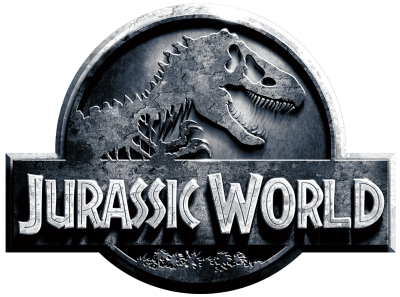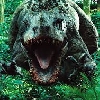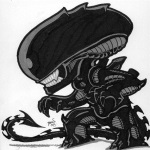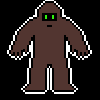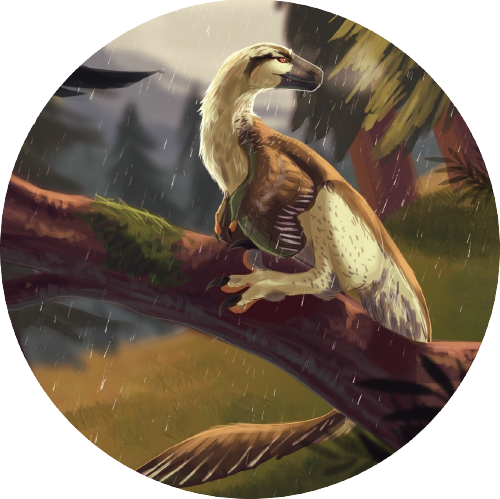
Baryonyx
Length- 9 M, although adults would have been larger (probably around 11 M)
Height- 2.4 M at the hips (larger for adults, around 3.6 M)
Weight- 2 tons (larger for adults, around 2.5-3.8 tons)
Baryonyx is a genus of theropod dinosaur which lived in the Barremian stage of the Early Cretaceous period, about 130–125 million years ago. The first skeleton was discovered in 1983 in the Smokejack Clay Pit, of Surrey, England, in sediments of the Weald Clay Formation, and became the holotype specimen of Baryonyx walkeri, named by palaeontologists Alan J. Charig and Angela C. Milner in 1986. The generic name, Baryonyx, means "heavy claw" and alludes to the animal's very large claw on the first finger; the specific name, walkeri, refers to its discoverer, amateur fossil collector William J. Walker. The holotype specimen is one of the most complete theropod skeletons from the UK (and remains the most complete Spinosaurid), and its discovery attracted media attention. Specimens later discovered in other parts of the United Kingdom and Iberia have also been assigned to the genus, though many have since been moved to new genera. Now recognised as a member of the family Spinosauridae, Baryonyx's affinities were obscure when it was discovered. Some researchers have suggested that Suchosaurus cultridens is a senior synonym (being an older name), and that Suchomimus tenerensis belongs in the same genus; subsequent authors have kept them separate. Baryonyx was the first theropod dinosaur demonstrated to have been piscivorous (fish-eating), as evidenced by fish scales in the stomach region of the holotype specimen. It may also have been an active predator of larger prey and a scavenger, since it also contained bones of a juvenile iguanodontid. The creature would have caught and processed its prey primarily with its forelimbs and large claws. Baryonyx may have had semiaquatic habits, and coexisted with other theropod, ornithopod, and sauropod dinosaurs, as well as pterosaurs, crocodiles, turtles and fishes, in a fluvial environment.
Carcharodontosaurus
Length- 12.7 M
Height- 4.3 M
Weight- 7.5 tons
Carcharodontosaurus is a genus of large carcharodontosaurid theropod dinosaur that existed during the Cenomanian age of the Late Cretaceous in Northern Africa. The genus Carcharodontosaurus is named after the shark genus Carcharodon. It is currently known to have two species: C. saharicus and C. iguidensis.
FIGHT!!!
Slap! A fish lands on the ground next to the huge Dinosaur. It is a Baryonyx, and it is fishing in the deep streams that turn this mudflat into a series of islands. The Baryonyx picks up the fish and tosses her head up, swallowing it whole. She can see her mate, about two hundred metres from where she’s standing. He is also hunting for fish. A recent forest fire has driven all the fish to this mudflat and these two Baryonyx are making the most of the plentiful food before competition arrives. However, they have no idea that they’re trespassing on the territory of a very large predator. A blurry shape in the distance moves into plain sight. It’s a juvenile Tyrannosaurus, about 7 metres long and very hungry looking. The female Baryonyx knows that the young Rex poses a threat to her eggs, which are in their nest, in the part of the forest where it is going. The Baryonyx gets her mates attention and they start jogging after the Rex. The Tyrannosaurus spots them coming and sprints for the forest. Something moves in the trees. Just as the Rex is about to reach the shelter of the forest, the branches snap and a massive Carcharodontosaurus emerges. The Rex looks up in alarm and tries to dash away. But it’s too slow, the Carcharodontosaurus lunges forward and picks it up by its back. The Rex squirms in the predator's mighty jaws, to no avail. The Carcharodontosaurus shakes the young Rex like a ragdoll and flings it into the middle of a stream. The water turns red and the Rex doesn’t get back up. The two Baryonyx start to back away slowly. Then the male’s leg sinks into a hole and twists badly. The Baryonyx struggles to get his injured leg out of the hole and the commotion attracts the attention of the Carcharodontosaurus. With a snarl of rage it lumbers towards them. The female has no choice but to fight, she dashes in front of her mate to stop the Carcharodontosaurus from getting to him. As the giant gets closer, she wonders if she should get out of here and leave her mate to die. She shakes her head, knowing that it is not an option, Baryonyx mate for life. Suddenly a shadow looms over her. She snaps her head up and stares into the cold, grey eyes of her enemy. For a moment the two Dinosaurs seem frozen in time, looking into each other’s souls. Then, without warning the Carcharodontosaurus opens his mouth and bites the Baryonyx on the snout before she can react. The Baryonyx struggles to get out of the much larger predator's grip, and the teeth sink deeper. The Carcharodontosaurus slams its head to the side and the Baryonyx feels her body meet the ground and her ribs crack. Stunned, she doesn’t even look up when the Carcharodontosaurus looms over her. Then as quickly as it appears it’s gone. She raises her head slightly and sees her mate, who has managed to free himself, although he is very slow and limping badly. But the male Baryonyx is a veteran while the Carcharodontosaurus is still young and inexperienced, he dodges the eager attacks with ease. The larger predator suddenly finds its stomach exposed and the Baryonyx bites it, tearing off chunks of flesh. However, you can’t dodge an angry Carcharodontosaurus for long, especially when you’re injured. The Baryonyx tries to dart out of the Carcharodontosaurus’ reach but the other Dinosaur is too quick. In a flash it has its jaws around the Baryonyx’ neck, and with a quick twitch of the head a loud crack echoes around the strangely silent mudflat and the Baryonyx’ limp body falls to the ground. The female Baryonyx gets up as quickly as her injured ribs will allow her to. She looks at her side and sees the tip of a stick protruding from her scales. With a wince, she pulls it out. A sudden noise snaps her to attention. The Carcharodontosaurus is beginning to advance towards her. With a last longing glance at her dead mate and her nest in the forest the Baryonyx turns and runs in the opposite direction
So, 3 points got to… the Carcharodontosaurus!
Why? The winning Dinosaur once again had the more effective weapons. Carcharodontosaurus had a weight advantage, a stronger bite and was just a more advanced Dinosaur. However, Baryonyx was probably slightly faster and smarter, it was definitely not a pushover.
 TriceratopsMember150 XP2022-12-19 09:53:00
TriceratopsMember150 XP2022-12-19 09:53:00Ummmmm....
 TriceratopsMember150 XP2022-12-19 09:54:00
TriceratopsMember150 XP2022-12-19 09:54:00Why do dinosaurs have stupid names
 AllosaurusMember2112 XP2022-12-20 02:55:00
AllosaurusMember2112 XP2022-12-20 02:55:00This fight is like Tyrannosaurus Rex versus a Spinosaurus, Carcharodontosaurus wins definitely.
 AllosaurusMember2112 XP2022-12-21 03:24:00
AllosaurusMember2112 XP2022-12-21 03:24:00By the way, When's the next battle?
No idea. I'm having a break until the 26th so some time after that. It's Yangchuanosaurus vs Yutyrannus.
 VelociraptorStaff1658 XP2022-12-23 07:15:00
VelociraptorStaff1658 XP2022-12-23 07:15:00@Hydra I wouldn't recommend doing that.
Consider this a little warning.
"Abs are not a sign of power, it's just a sign you don't eat enough."-JF Caron
 AllosaurusMember2112 XP2022-12-28 17:30:00
AllosaurusMember2112 XP2022-12-28 17:30:00Dakotaraptor_27 Maybe do lesser battles that are related to semi-aquatic dinosaurs like Spinosaurus or Baryonyx against larger and built-for-land dinosaurs like Giganotosaurus or Allosaurus, It makes the battle kind of easy to decide. Mostly the land Dinosaurs would most likely win depending on their semi-aquatic opponent's size, etc capabilities, and the Terrain or environment they are at. Just to let you know. :/
